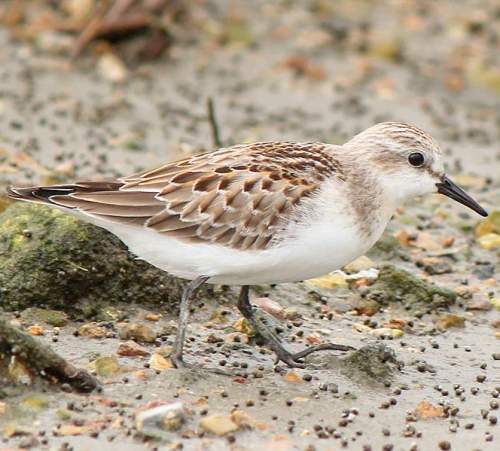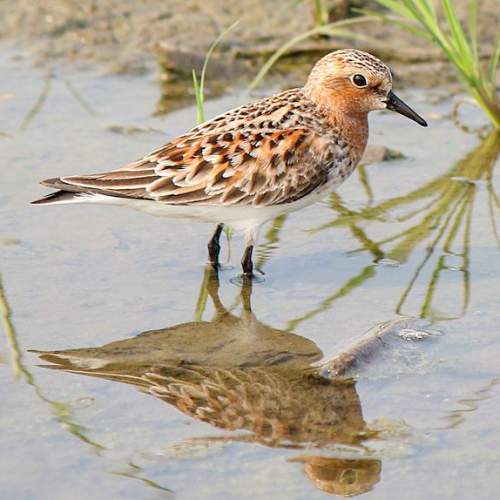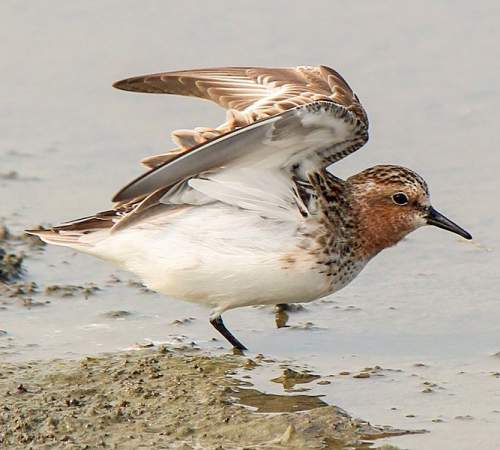Bird World › List of Indian quails with images › Red-necked stint - Calidris ruficollis
The red-necked stint (Calidris ruficollis) belongs to the family of sandpipers, curlews and stints, the Scolopacidae.The red-necked stint is distributed in Alaska, northeast Russia, southeast China, southeast Asia, India, Bangladesh, Sri Lanka, Australia and New Zealand. The stint species is fully migratory. The stint species is monotypic.
Appearance, physical description and identification
The red-necked stint (Calidris ruficollis) is a small wader, measuring 12 to 17 cm in length and weighing 20 to 50 grams. The wingspan is 30 to 35 cm.The breeding red-necked stint has reddish face, cheek and throat. The crown is pale with fine dark brown striations. There is grayish lore. The upperparts are whitish with dark brown and rufous patterns.
In wintering red-necked stint the neck and the face are whitish. The lore is paler. The upperparts are grayish brown with large leaf-like patterns. The underbelly and undertail are white in both the forms.
The bill is long, sharp and dark. The legs and feet are blackish. The irises are blackish brown. There is a pale eye-ring. The red-necked stint call is a sharp, loud "quik.. quik", "queek.. queek" and "chripp.. chripp" sound.
 |
| 1.Red-necked stint - Calidris ruficollis Image by Alpsdake |
 |
| 2.Red-necked stint - Calidris ruficollis Image by Alpsdake |
 |
| 3.Red-necked stint - Calidris ruficollis Image by Alpsdake |
Origin, geographical range and distribution
The breeding populations of the red-necked stint are distributed in Arctic and subarctic northeast Russia and northwest and west Alaska.The wintering stint populations occur in southern China, southeast Asia, eastern India, Bangladesh, Sri Lanka, Australia and New Zealand.
Vagrant populations of the red-necked stint occur in Canada, western coast of USA, United Kingdom, Belgium, Denmark, Finland, Germany, France, Netherlands, Sweden, Norway, Kazakhstan, South Africa, Israel and United Arab Emirates.
The Important Bird and Biodiversity Areas (IBA) of the red-necked stint in Russia are, Moroshechnaya River, Babushkina and Kekurnyy Gulfs, Malakchan bay, Bol'shaya River Estuary and Geka bay.
The IBA of the stint species in South Korea are, Nakdong-gang estuary, Cheonsu Bay, Mangyeong estuary and Dongjin estuary. The IBA in China are, Yong Jiang Estuary, Xuanmen Wan, Taizhou Wan and Lianyungang saltworks.
Ecosystem and habitat
The red-necked stint species does not normally occur in forest. It normally occurs in altitudes between 0 to 500 meters.The natural ecosystems and habitats of the red-necked stint species include tundra grasslands, subalpine grassland belt, shoreline, estuaries, lagoons, tide pools, intertidal mudflats, marshes and freshwater wetlands.
Diet and feeding behavior
The diet of the red-necked stint species consists mainly of small invertebrates. Insects, insect larvae, beetles, sawflies, wasps, bees, ants and small seeds are their primary food.Reproduction and breeding habits
The breeding season of the red-necked stint species is during May and June in most of their breeding range. They are monogamous and territorial. They may breed in loose colonies.The breeding habitats include low altitude montane tundra and tundra grasslands. The nest is a shallow depression on the ground.
Migration and movement patterns
These red-necked stint species are fully migratory birds. The breeding populations occur in northeast Arctic and subarctic Russia and sporadically in north and west Alaska (USA).These stint species leave breeding grounds during August-September to winter in coastal regions of Bangladesh, India, Sri Lanka, southeast Asia, southern China, Australia and New Zealand.
The return migration to the breeding grounds takes place from mid-April to early May. During migration, these birds pass through stopover sites in Japan, North Korea, South Korea, China and southeast Asia.
Red-necked stint - Quick Facts
- Scientific name: Calidris ruficollis
- Species author: (Pallas, 1776)
- Synonyms/Protonym: Trynga ruficollis Pallas, 1776
- Family: Scolopacidae › Charadriiformes › Aves › Chordata › Animalia
- Vernacular names: English: Red-necked stint, Chinese: 红颈滨鹬, French: Bécasseau à col roux, German: Rotkehl-Strandläufer, Spanish: Correlimos cuellirrojo, Russian: Песочник-красношейка, Japanese: トウネン
- Other names: Red-necked Stint, Rufous-necked Stint
- Distribution:Alaska, northeast Russia, southeast China, southeast Asia, India, Bangladesh, Sri Lanka, Australia, New Zealand
- Diet and feeding habits: insects, insect larvae, beetles, seeds
- IUCN status listing: Near Threatened (NT)
Conservation and survival
The global population size of the red-necked stint (Calidris ruficollis) is estimated to be about 315,000 individual birds by Wetlands International in 2015. The overall population trend of the species is reported to be declining.In most of its range, this stint species is reported to be uncommon to rare. The generation length is 7.5 years. Its breeding and wintering distribution size is about 3,360,000 sq.km.
Ecosystem degradation, ecosystem conversion, severe weather, climate change, habitat loss at stopover sites, hunting and pollution are the main threats that may endanger the survival of the stint species.
IUCN and CITES status
The red-necked stint (Calidris ruficollis) species is approaching the thresholds for being Vulnerable under the range size criterion, under the population trend criterion and under the population size criterion.The IUCN (International Union for Conservation of Nature) has categorized and evaluated the species and has listed it as "Near Threatened (NT)".
The CITES (Convention on International Trade in Endangered Species of Wild Fauna and Flora) status is ‘Not Evaluated’ for the red-necked stint (Calidris ruficollis).
1.Image source: https://commons.wikimedia.org/wiki/File:Calidris_ruficollis_in_Fujimae-higata.JPG (cropped)
Author: Alpsdake | License: CC BY-SA 3.0 as on 1/5/19
2.Image source: https://commons.wikimedia.org/wiki/File:Calidris_ruficollis_summer_plumage.JPG (cropped)
Author: Alpsdake | License: CC BY-SA 3.0 as on 1/5/19
3.Image source: https://commons.wikimedia.org/wiki/File:Calidris_ruficollis_wing.JPG (cropped)
Author: Alpsdake | License: CC BY-SA 3.0 as on 1/5/19
Link to Creative Commons copyright licenses
Updated Jan 4, 2019
Recently updated and current topic in Bird World: Red-necked stint (Calidris ruficollis).
